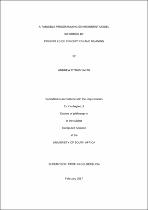 ResearchSpace
ResearchSpace
A tangible programming environment model informed by principles of perception and meaning
JavaScript is disabled for your browser. Some features of this site may not work without it.
- ResearchSpace
- →
- Archives collection
- →
- Open Access Reports
- →
- View Item
| dc.contributor.author |
Smith, Andrew C

|
|
| dc.date.accessioned | 2019-01-18T13:15:20Z | |
| dc.date.available | 2019-01-18T13:15:20Z | |
| dc.date.issued | 2018-09 | |
| dc.identifier.citation | Smith, A.C. 2018. A tangible programming environment model informed by principles of perception and meaning. Submitted in accordance with the requirements for the degree of Doctor of philosophy in the subject Computer Science at the University of South Africa | en_US |
| dc.identifier.uri | http://uir.unisa.ac.za/handle/10500/24850 | |
| dc.identifier.uri | http://hdl.handle.net/10204/10626 | |
| dc.description | Submitted in accordance with the requirements for the degree of Doctor of philosophy in the subject Computer Science at the University of South Africa | en_US |
| dc.description.abstract | It is a fundamental Human-Computer Interaction problem to design a tangible programming environment for use by multiple persons that can also be individualised. This problem has its origin in the phenomenon that the meaning an object holds can vary across individuals. The Semiotics Research Domain studies the meaning objects hold. This research investigated a solution based on the user designing aspects of the environment at a time after it has been made operational and when the development team is no longer available to implement the user’s design requirements. | en_US |
| dc.language.iso | en | en_US |
| dc.relation.ispartofseries | Worklist;21162 | |
| dc.subject | Gestalt principles | en_US |
| dc.subject | Grouping by proximity | en_US |
| dc.subject | Perception | en_US |
| dc.subject | Personally meaningful | en_US |
| dc.subject | Programming | en_US |
| dc.subject | Programming language | en_US |
| dc.subject | Semiotic theory | en_US |
| dc.subject | Signs | en_US |
| dc.subject | Tangible program | en_US |
| dc.subject | Tangible user interface | en_US |
| dc.title | A tangible programming environment model informed by principles of perception and meaning | en_US |
| dc.type | Report | en_US |
| dc.identifier.apacitation | Smith, A. C. (2018). <i>A tangible programming environment model informed by principles of perception and meaning</i> (Worklist;21162). Retrieved from http://hdl.handle.net/10204/10626 | en_ZA |
| dc.identifier.chicagocitation | Smith, Andrew C <i>A tangible programming environment model informed by principles of perception and meaning.</i> Worklist;21162. 2018. http://hdl.handle.net/10204/10626 | en_ZA |
| dc.identifier.vancouvercitation | Smith AC. A tangible programming environment model informed by principles of perception and meaning. 2018 [cited yyyy month dd]. Available from: http://hdl.handle.net/10204/10626 | en_ZA |
| dc.identifier.ris | TY - Report AU - Smith, Andrew C AB - It is a fundamental Human-Computer Interaction problem to design a tangible programming environment for use by multiple persons that can also be individualised. This problem has its origin in the phenomenon that the meaning an object holds can vary across individuals. The Semiotics Research Domain studies the meaning objects hold. This research investigated a solution based on the user designing aspects of the environment at a time after it has been made operational and when the development team is no longer available to implement the user’s design requirements. DA - 2018-09 DB - ResearchSpace DP - CSIR KW - Gestalt principles KW - Grouping by proximity KW - Perception KW - Personally meaningful KW - Programming KW - Programming language KW - Semiotic theory KW - Signs KW - Tangible program KW - Tangible user interface LK - https://researchspace.csir.co.za PY - 2018 T1 - A tangible programming environment model informed by principles of perception and meaning TI - A tangible programming environment model informed by principles of perception and meaning UR - http://hdl.handle.net/10204/10626 ER - | en_ZA |





